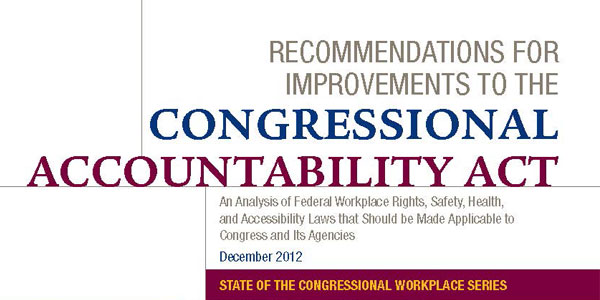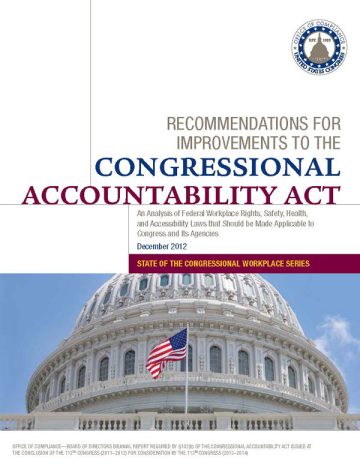STATEMENT FROM THE BOARD OF DIRECTORS
With the passage of the Congressional Accountability Act of 1995 (CAA), Congress became accountable—for the first time—under major federal civil rights statutes that apply to private sector and Federal Executive Branch employers, such as the Americans with Disabilities Act of 1990, and safety and health standards under the Occupational Safety and Health Act of 1970. As outlined in our annual reports, “State of the Congressional Workplace”, the CAA brought substantial improvements to the Legislative Branch in the areas of safety and health, access for people with disabilities, and a meaningful legal process for Congressional employees to administer their employment rights.
The CAA established the Office of Compliance (OOC) to: administer a dispute resolution program for claims brought by Congressional employees under the CAA; carry out an education program to inform Congressional Members, employing offices, and employees about their rights and obligations under the CAA; inspect Congressional facilities for compliance with safety and health and accessibility laws; and, under the guidance of the Board of Directors, promulgate regulations and make recommendations for changes to the CAA to keep Congress accountable under current workplace laws that apply to private and public employers.
This latter role of the Board is the subject of this report. The CAA was drafted in a manner that demonstrates that Congress intended that there be an ongoing, vigilant review of the workplace laws that apply to Congress. In so doing, Congress would be held accountable under the same Federal workplace laws that apply to private businesses, the Federal Executive Branch, and the American people. At its core, § 102(b) of the CAA asks the Board of Directors for the OOC to report, on a biennial basis:
whether or to what degree [provisions of Federal law (including regulations) relating to (A) the terms and conditions of employment (including hiring, promotion, demotion, termination, salary, wages, overtime compensation, benefits, work assignments or reassignments, grievance and disciplinary procedures, protection from discrimination in personnel actions, occupational health and safety, and family and medical and other leave) of employees; and (B) access to public services and accommodations]… are applicable or inapplicable to the legislative branch, and (B) with respect to provisions inapplicable to the legislative branch, whether such provisions should be made applicable to the legislative branch. The presiding officers of the House of Representatives and the Senate shall cause each such report to be printed in the Congressional Record and each such report shall be referred to the committees of the House of Representatives and the Senate with jurisdiction.
This report analyzes certain “parity gaps” between Federal workplace rights laws that apply to employers in the private sector as compared to Congress and its agencies, and recommends whether these laws should be made applicable to the Legislative Branch through the CAA.
The recommendations made by the Board in this report make clear that coverage under the CAA is incomplete. The Board’s required analysis under § 102(b) of the CAA demonstrates that Congress remains exempt from certain workplace laws that it passed to hold private and public sector employers accountable. Indeed, the vast majority of the laws that we recommend in this report apply to Congress existed at the time the CAA was passed. Most of the recommendations the Board makes here have been made in prior reports. The Board reiterates these recommendations to emphasize the need for these protections. In some cases, the Board identifies Congressional exemption from entire statutes, such as the Whistleblower Protection Act of 1989. Congress recognizes whistleblowers as a key resource in weeding out fraud and misuse of taxpayer dollars in the Federal Executive Branch and under some laws in the private sector, yet its own employees are denied whistleblower protection from retaliation if they report such behaviors.

